Text
Introduction and Story
The further I get into my life, the more apparent it is that I can’t pass by any Action-RPG in hopes of recreating my experience with Diablo II. After my somewhat disappointing experience with Wolcen, both pre-release and post-release, the next attempt at a new game is Last Epoch.
As a general heads up, Last Epoch is also currently in Beta Release and is incomplete. You can check out the details at their website or on Steam for purchase.
The story of Last Epoch is unfortunately not that important in its current incomplete state. The one thing that should be known (and happens in the first ten minutes of playing) is the realization that you are basically playing through the same maps/areas in different time periods ala Chrono Trigger. This brings up interesting ideas when it comes to time travel and seeing the same characters across multiple ages, but it also means that unless repeat locations are drastically different, it can get a bit boring. I felt that some of the repeat sections were just not varied enough to really feel like I was playing a new map area.
There’s also a reliance on highly coincidental decisions on the part of the NPC’s you are interacting with. At one point in the story, which I’ll show a screenshot for below, you are traveling with a companion to acquire an item. Before stepping into an obvious boss room, the NPC stops and, well, you’ll see below.
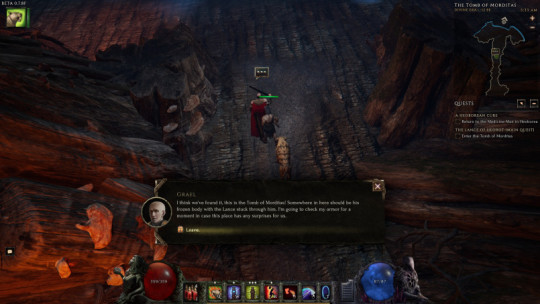
My opinion of story telling going into an unlikable direction.
Some instances are a bit funny and I wonder if there’s just limitations on the back end that we aren’t seeing. There is one story beat where you save a NPC on a boat with the goal of jumping off the boat to escape. Instead of just freeing the NPC and having him follow you, he says he will wait until we are ready to jump off the boat before following. You have to go to the side of the boat, click jump off, then you both appear at an island after a loading screen. The game allows NPC’s to follow you at other points, but situations like this do happen often enough to stick out as being strange.
Skills and Specializations
Last Epoch looks to have five characters available, eventually. Right now, there are four; Acolyte, Primalist, Sentinel and Mage. Each of these character types will eventually have three different master class specializations to choose from. The Mage for example has Spellblade, Sorceror and Runemaster as master classes however, only Spellblade and Sorceror are currently available. That being said, there is a lot to check out in its current state.
Here’s where things get a bit more interesting. Each character has a default passive skill tree which you’re able to put points into either from leveling up or from set quest rewards. To go along with that, each of your characters skills are planned to have a skill tree. And finally, on top of that, opening up the master class of your choosing opens up those passive skill trees for you to put your points into.

Example of what the skill tree for Hammer Throw looks like. Each skill gets 20 skills points to distribute within their trees.
The end result for setups like this should involve a lot of customization towards how the player wants to play, and in some ways I see that succeeding. Early on, I attempted a Sentinel with Hammer Throw as the main attack. Initially, hammer throw shoots in a straight line outward, then comes back to the player. Within the skill tree, you can have the hammers spiral around the player, or shoot out in a nova around the player. You can also opt to skip these skill nodes entirely and head for a more stun orientated hammer. The point is that there are options to change the way you are playing.
Items and Crafting
Items are set up in a similar way to what you may already be used to. You have your white base items without any affixes, blue magic items with 1-2 affixes, rare yellow items with 3-4 affixes, unique gold items and green set items.
Throughout your game time, you’ll inevitably pick up tons of shards. These shards are the affixes that appear on item drops. The idea with the crafting setup is to use these shards to put specific prefix or suffixes onto items (two of each for a total of four mods on an item).
Each of these item affixes are ranked between Tiers 1-5. So tier one of ‘Elemental Protection’ may be a ranged value between 25 – 50, while tier two may have a range of 50-75. You can’t just find shards and rank every affix up to tier 5 though. Each item has stability attached to it. The more unstable a weapon is from crafting, the more likely it is to fracture (can’t upgrade any more mods). This becomes a risk/reward system where you’re more than welcome to attempt a low % upgrade, but the risk is not being able to upgrade it any further.

The crafting screen in Last Epoch. This example shows Increased Health % at Tier 4, Increased Mana % at Tier 2 and Chance to Chill Attacks at Tier 1. You can add one more prefix to this item as well as upgrade the Tiers of current affixes.
Along with finding shards as item drops, you also have the ability to shatter items with desirable affixes on them to potentially receive shards of those affixes. Towards end game, this turns into a sort of mini game of knowing what rare affixes are on items so that you can pick those up, shatter them, get shards of desired affixes and put them onto your item of choice later.
You also have the ability to gamble rare items. It wasn’t uncommon for me to decide I needed new gloves for example, then gamble gloves and hope for at least 2-3 good affixes that I can work with.
I don’t dislike this system, but it also feels a bit cumbersome. There are over 100 affixes in the game and it felt impossible to really understand what is needed for the character I was playing due to tool-tips not currently being included in the game. One way you can tell is by throwing a picked up item into your crafting window. This will automatically bring up the affixes on that item to the top of your screen so that you can upgrade them. Here, they show you how many shards you have of that affix. It’s just not realistic to do that for every item.
Selling items is also awkward because they do not hold much value at all. I could pick up an entire inventory of weapons and armor only to make 1000 gold. For reference, gambling one pair of gloves could run me 1400 gold. The incentive to pick up items is to shatter them for affixes, but the act of knowing what to save outside of memory is too time consuming.
Enemies and Game Balance
Enemy types are typical for ARPGs. You have regular white mobs, blue magic mobs, gold rare mobs and then unique/named mobs or bosses. More often than not, you’ll see yourself facing down a combination of all of the above at the same time.
An interesting aspect that I noticed, was that you can’t really get away from any enemies. In most…if not every other APRG I’ve played, if you want to skip a group of enemies that have an immunity you don’t want to deal with, or a pack of stronger mobs that have an unfortunate set of affixes attached to them, just run by and eventually you don’t have to worry about them anymore. Last Epoch seems to entirely remove that idea.
The reality of this game is that you just won’t be that strong against stronger enemies until much later into the leveling process, and even there, you need to make sure your build is cohesive enough to do any real damage and make progress into the current end game.
To a certain degree, I feel like enemies can be placed into a few different categories; fodder, B-Tier, A-Tier and S-Tier. Fodder are typical filler mobs that will die within one or two hits. B-Tier include more complicated enemies with some sort of more notable mechanic like healing or shielding other enemy types. A-Tier are what you would think are the strongest mob types in the game with high health, high damage output and massive AoE attacks that must be avoided in fear of death. Lastly, S-Tier are everything that A-Tier mobs are, but multiplied.
The affix’s that mobs are given can be both interesting and frustrating. You have your basics like ‘More Health’ and ‘Higher Chance to Critical Hit’ but Last Epoch also has some that I don’t believe I’ve seen before like ‘Revives After Two Seconds’ and ‘Summons a Twin at Half Health.’
Now, I’m all for variation and difficulty in games like this. I think that my greater issue is that enemy placement when looking at these tier lists just doesn’t make sense. There are two different ways I was looking at this; story and end game.
While you’re going through the current story, difficulty seems to progress at a normal pace with spikes once you reach certain areas. Not a problem in itself, but I noticed a pattern. A large portion of the maps were turning into ‘small pathway leading to large opening’ where the large opening had a few fodder mobs, a few B-Tier mobs, and multiple A or S Tier mobs. This typically meant that for every sort of room you go into, you can be there for 20-30 seconds just burning down one of these higher tiered mobs. Once that is complete, you move to the next small path and large room where you repeat the process. It became noticeably formulaic. On my first character going through the last Act of the game, I really just felt burnt out by the time I defeated the boss and got to the end game.
I’ll go into end game a bit more soon, but for these purposes, I felt like it was the bigger offender. End game areas can be quite a mess. I’ve hit brand new monolith maps where the first large room I get to has 8+ A-Tier mobs with massive health pools and massive AoE attacks. At that point, it’s better to just die and get a new monolith map than to struggle for 5+ minutes trying to kill every one of those mobs.
Now imagine all of these things combined. You have multiple A or S tiered mobs in one location, they have affixes such as ‘More Health’ AND ‘Revives After Two Seconds’ which revives that mob at half health, and you can’t get away from them because of how mobs are attached to the player once they see you. Yikes. The experience reward for defeating one of these mobs isn’t worth the time it takes to defeat them.
Endgame
The current end game features two different aspects, arena battles and monoliths.
Monoliths: This is where you will spend the majority of your time in Last Epoch once the story mode is complete. Once you reach end game, you can click on a giant monolith which will send you to a different timeline to defeat monsters. These maps are varied and include most of what you have already seen in the main game and as far as I can tell, contains random combinations of enemies.
This slideshow requires JavaScript.
Once clicking the monolith, you have the option to choose from one of two enemy modifications. One example could be ‘For the next two timelines, enemies have +25% critical strike chance’ and ‘For the next two timelines, enemies deal 12% increased damage and have 100% increased critical strike chance.’ The former is obviously better, but the latter actually gives the player higher item drop chances and higher experience earned. There is also the option to re-roll these two mods once every time you choose a timeline. This can become a gamble though as you get further along and you could be giving up a bad enemy modification for a terrible one.
As you complete more timelines, things can get hectic very fast. Early on, enemy mods may stay for two timelines then disappear, but then these modifications stay for four timelines, then seven timelines and so on. The result ends up being a giant mess of increased issues for you to deal with with the idea of more risks involved, more rewards for tackling it.
Arena Battles: Arena battles require you to first find Arena Keys from Monoliths and is exactly what it sounds like. You are in a large room with waves of enemies that come rushing towards you. Every five waves you are given access to your stash, minor item rewards and the ability to choose to end the arena or continue for another five waves.
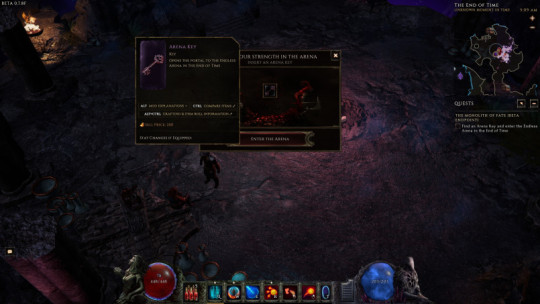
Joining an arena battle with a found Arena Key.
Overall, this end game setup is decent. Monoliths have enough variety to not get boring too fast. Wolcen had a similar setup but lacked variety to the point to where you really only got a few different maps and a few different bosses/enemy combinations to take on.
I do wish there was another objective here besides simply leveling your character and trying to find decent items with Tier 5 affixes on them. While Wolcen’s end game is boring, the city building aspect was at least an interesting idea. Path of Exile has maps which do get redundant, but having the map Atlas gave an overarching goal to work towards while completing those maps.
Other Thoughts
Pathing: The pathing can be quite strange in Last Epoch. What I mean by that, is how your character moves to certain locations based on where your are pointing with your mouse. There were multiple occasions where I thought I was in a large open hallway and directing my character forward when he would abruptly turn around and head in the opposite direction. This also become a more noticeable issue because my character with the most investment was a Warpath using Forge Guard which seems to increase that behavior.
Bugs: Last Epoch is in Beta, there are bugs and that shouldn’t deter you from giving it a shot if you do enjoy APRGs. If the idea of being locked out of an area and needing to reload does bother you, just skip it for now. There were a few times I had entered a side area just to be locked out from returning. I would have to portal out and use the nearest waypoint to head back to where I originally was.

Harmless graphic bug that you might see while playing.
Damage Tool-tip: As it stands, besides one obscure DPS number on your character sheet which I believe is only attached to melee attacks, there’s no real damage tool-tips for your characters or skills. This leaves you guessing when trying out new items or points on your skill tree. After experiencing Wolcen and it’s skill tree nodes that were just not working, I wanted some reassurance that I wasn’t wasting piles of skill points into skills that were not benefiting my character. I’m sure this feature will be added into the game at some point.
Global Chat: Right now, Last Epoch is a single player game. However, global chat is attached to the game so that you can converse with your fellow players. My experience was a hard mix between Barrens chat from Vanilla WoW and players that genuinely want to help. Any mention of Diablo 3 meant likely crucifixion. Mention of Path of Exile meant that it was no longer stream lined enough. Wolcen, well, is still Wolcen.

Yea, global chat.
Quest Rewards: One thing that I had noticed is that quest rewards that do not result in extra idol slots or passive skills are largely a waste of time. You will receive gold and experience, but they are so insignificant that they just don’t matter. At the very least, the rewards should be increased.
Shrines: Last Epoch includes shrines that actually last for a decent amount of time and have some unique properties. Included in the shrine pool are ones that cause every attack to be a critical strike and another has a unique item drop once clicked.
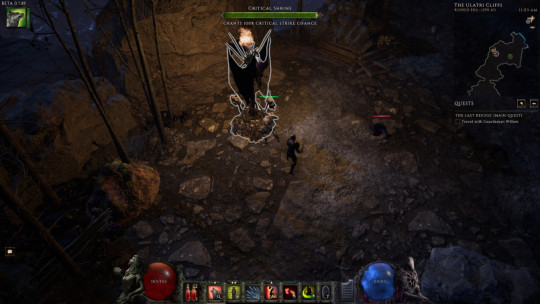
One example of a shrine in Last Epoch.
Final Thoughts
I had a lot to say about enemies earlier, but I do feel that small tweaks can fix my overall issues. Some affixes need to be adjusted, some experience rewards need to be increased and damage output/mitigation needs to be looked at. All of these have numbers attached to them and I believe they are fixable and necessary to reach more of a balance.
Outside of that, I enjoy that individual skill trees have customization built in to them. You can spec into Hammer Throw and decide between your hammers coming out in a line, nova or spiral. You can spec into ‘Volcanic Orb’ and choose to instead make it a ‘Frozen Orb’ akin to Diablo II. Choices around the skills matter. One skill with one specialization tree, can seem like two or three different skills.
The trick here is to then have Unique/Set items play off these different specializations and increase the variety of things that you can do while combining all of these aspects. I didn’t see a lot of that from the thirty or so Unique/Set items that I had found. More often than not, rares with higher tiered specific mods were much better than any Unique or Set that I had found. I think that’s good for crafting, but there should also be worthy items on the other side to consider.
At the end of the day, and after playing for around 70 hours, I felt that Last Epoch is fun and worth the time to play. There’s a lot of good here, a lot more than I’ve seen out of Wolcen and a lot more user friendly than the current state of Path of Exile. I will definitely keep checking out updates to this game and see what the final product eventually looks like in comparison to now.
Thanks for reading. I’ve written a bunch regarding Action-RPGs on this site, the following are a few of those times;
Path of Diablo: Part I, Part II, Part III
Median XL: Sigma
Wolcen: Beta Release, Full Release
First Thoughts: Last Epoch (Beta Release) The latest Action RPG that was on my list to check out. Lot of good vibes from Last Epoch and looking forward to the full release. #lastepoch #steam #arpg #wolcen #diablo #torchlight Introduction and Story The further I get into my life, the more apparent it is that I can't pass by any Action-RPG in hopes of recreating my experience with…
#action rpg#arpg#chrono trigger#diablo#diablo 2#last epoch#path of diablo#path of exile#pc#pc games#poe#steam#video games#wolcen
0 notes
Text
Return of the Bonemancer
So, it’s been quite a long time since publishing Path of Diablo: Part II. In that article, I was ready to dive into Hell difficulty with my good ol’ Ravens Druid. Unfortunately, interest kind of dropped off once I reached Hell. The difficulty of course spiked, it became more tiresome to play, so I decided to hang the pelts up and wait for the interest to come back to me.
Surprise, the interest came back to me. Diablo II: Remastered has been heavily rumored for a few years now, more so in recent months. I’ve started to notice that just like I want to re-watch Lord of the Rings every time I see something Lord of the Rings related, whenever I hear something new about Diablo II, I get that itch again.
I felt that Path of Diablo never really got that full shake from me, so in I dove again. This mod of the game has now reached it’s 18th patch, dubbed Flint, three patches past my last article in this series.
I feel like whenever I re-start Diablo II, the go to character is always a Sorceress to utilize Teleport and make things quite a bit easier. I ended up changing that formula with a Druid the first time with Path of Diablo, so I took the same approach this time.
In my time of playing Diablo II, I never really gave the Necromancer much attention. At various times, I did have a Poisonmancer, Summonancer and Bonemancer, but they were really just made out of boredom and they were never long lasting.
After reading the more recent patch notes, I saw something amazing.

Yes. Bone Spear shoots two additional spears every cast. I had my new character. With the increased damage from the very first patch and the additional spears in patch #18, it didn’t even feel like a debate. I always loved Bone Spear as a skill, it just never felt like a heavy hitter on its own. You always had to cast bone walls to block enemies in, then in a way, slowly damage them with Bone Spears, not the most dynamic or exciting gameplay. Here, the potential was much greater for a fun spin on an old skill.
Normal, Nightmare and Hell
This would typically be the point to where I speak on how leveling overall went as a Bonemancer…with my three Bone Spears. Honestly, that story would be incredibly boring. It was fantastic. I can’t really point out any specific moment where I had any sort of difficulty. The usual points of fear like the Chaos Sanctuary or Hell Ancients were just blips on the radar and before I knew it, I had defeated Baal and started aiming to clear maps, Path of Diablo’s new end game.

Three Bone Spears are definitely better than one.
In terms of gear, I aimed for a few basic rune words to help things along. The rune word ‘White‘ is a staple among most Bonemancers, and is easy enough to obtain for anyone only requiring two runes; Dol and Io. The great thing about White (aside from its already +3 Poison and Bone Skills and +2 Bone Spear bonuses) is that you can find an open, two-socket wand with + Bone Spear already built in, giving you more of a skill bonus to your bone spear.
This slideshow requires JavaScript.
‘Spirit‘ is also a no brainer for a lot of builds at least early on before finding better gear and creating more expensive rune words. It does require a four-socket weapon or shield, but there are plenty of cases where you can actually use the socket quest from Larzuk in Act V to receive those four open sockets. In a shield, you receive +2 to All Skills, faster cast rate, faster hit recovery, resists and more.
Endgame for Path of Diablo is similar to Path of Exile in that we have maps to run. I started to delve into Tier 1 Maps on this Bonemancer (out of 4 Tiers) but haven’t gone much further than that at this time. Maybe I will detail that aspect of the game in a later addition to this series.
Loot Filters
One great aspect of Path of Diablo, is the ability to implement a loot filter, similar to Path of Exile. In Action RPG’s like your Diablo games, loot is incredibly important. It’s vital that you try to maximize your characters equipment at all times. Even more important if you’re playing online, you want to know what is valuable so that you can sell or trade those items away to increase your wealth.
There are a variety of loot filters that are available to the player and they can be found here. Each filter is incredibly simple to implement with following the directions on the previously linked page. I’m using the Pure Karma filter myself, but each has their benefits.
This slideshow requires JavaScript.
Quality of life is also increased with this loot filter. Instead of ‘Greater Healing Potion,’ popping up and filling your screen as a common drop, you have a red symbol (and blue for mana and so on). Higher ranked runes are now blasted with symbols on your screen to make it as unlikely as possible to miss them. Since ‘Spirit‘ is a ridiculously good rune word, things like your typical white Crystal Swords will now say ‘Spirit Base’ beforehand so the player knows that they can just throw that weapon into Larzuk’s socket quest and create a Spirit rune word.
Extra Bowazon Action
Outside of plowing through Hell with the Necromancer, I decided to start a Bowazon. Why? Two different items; Arctic Bow and Hailstorm, unique arrows. With both of these items equipped, and both having a very low level requirement, I’m flying through normal difficulty while shooting five cold arrows per shot. It effectively gives you a cold infused multi-shot.
This slideshow requires JavaScript.
Is this something that’s long lasting? No, of course not. Arctic Horn has a level 2 requirement to use and only has a damage range of 9 – 21. I’ll soon be shifting to Kuko Shakaku and some sort of fire arrow build, but this is an example of new things that Path of Diablo offers, especially for older players.
Just the idea of having a new experience with a Bowazon in normal difficulty was enough for me to roll the character and give it a shot. A similar thing happened with the Necromancer. Just the idea that I can shoot three Bone Spears instead of one every cast made me want to create that character so that I could have a new experience within Diablo II.
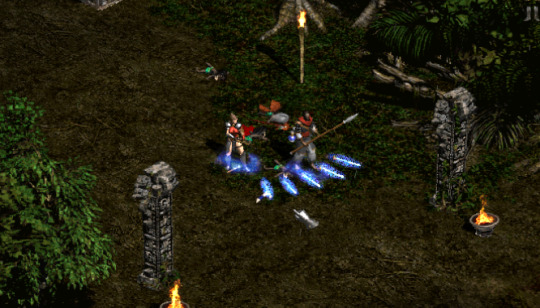
The result of having both Arctic Horn and Hailstorm equipped; five cold arrows per shot.
Path of Diablo isn’t flashy like your Median XL‘s or Eastern Sun’s, but it does a very good job of many changes to the base game without making Diablo II not feel like Diablo II.
I’m sure that I’ll keep adding to this series over time as I get that renewed Diablo II feeling that always seems to swell over me. For now, I’m content progressing with my triple Bone Spear Necromancer.
As always, check out the following links for previous articles and resources related to Diablo II and Path of Diablo;
Path of Diablo: Part I
Path of Diablo: Part II
First Thoughts – Diablo II: Median XL Sigma
Diablo Immortal
Official Path of Diablo Subreddit
Official Path of Diablo Wiki
How to Install Path of Diablo
Path of Diablo: Part III Returning to #pathofdiablo to check out some Bonemancer action! #diablo #diablo2 #pathofexile Return of the Bonemancer So, it's been quite a long time since publishing Path of Diablo: Part II…
#action rpg#amazon#d2#d3#d4#diablo 2#diablo 3#diablo 4#druid#lord of the rings#necromancer#path of diablo#path of exile#pc games#pod#poe#remaster#sorceress
0 notes
Text
Vote.
With this movement continuing to march on, I’ve had a lot of thoughts and feelings about how I want to attempt to help. I can’t go out and protest safely with CV-19 still an uncertainty and the risk is too great with a baby in this house. However, I do have this platform.
Look, I’m a white male with blonde hair and blue eyes. I don’t have and real, life consequential problems that I deal with on…
View On WordPress
0 notes
Text
I Wasn't Prepared for World of Warcraft II: Molten Core and Beyond
Thanks for checking out this retrospective / introspective recounting of my World of Warcraft experience. If you’re looking for Part I of this journey, check it out here. In terms of timelines, this section covers between hitting level 60 and nearly the entirety of World of Warcraft’s first expansion, Burning Crusades, lifespan; approximately January 2006 – July 2008.
Preparing for Molten Core
Th…
View On WordPress
#blackwing lair#blizzard#books#boss fights#burning crusade#friends#Gaming#humble bundle#life#mmo#mmorpg#molten core#pc#pc games#ragnaros#razorgore#social#video games#world of warcraft#wow
0 notes
Text
I Wasn't Prepared for World of Warcraft I: The Beginning
Introduction
About a year ago, I came across a bundle of e-books on Humble Bundle by Boss Fights Books. At the time, I had no idea what these books were, what they entailed or who the authors were. I just knew that some of the games that were included in the bundle were Final Fantasy V, Chrono Trigger, Earthbound and World of Warcraft. That was enough for me, I bought them.
After a closer look, I…
View On WordPress
#books#boss fights#command & conquer#diablo#friends#Gaming#humble bundle#life#meshuggah#mmo#mmorpg#pc#pc games#social#starcraft#video games#warcraft#world of warcraft#wow
0 notes
Text
My Problem With Dragon's Dogma
A great game with a fantastically stupid error. My Problem With Dragon's Dogma #nintendo #nintendoswitch #dragonsdogma #rpg #jrpg #skyrim #darksouls #masseffect #dragonsage
I debated writing this article because my veins are currently infused with a hefty dose of salt large enough to make me float for a week. I just lost 35 hours of progress in Dragon’s Dogma, and we’ll eventually get to why.
Throughout the years, I’ve made an effort to start Dragon’s Dogmatwo different times. Once on the Playstation 3 somewhere in 2013 when the expansion, Dark Arisen, released.…
View On WordPress
#capcom#dark souls#dragon age#dragons dogma#fallout#ffvii#ffxv#jrpg#mass effect#nintendo#nintendo switch#ps3#ps4#rpg#skyrim#video games
0 notes
Text
Review: Shalnor Legends: Sacred Lands
Is this $0.99 Nintendo eShop purchase worth playing? Review: Shalnor Legends: Sacred Lands #nintendo #nintendoswitch #shalnorlegends #zelda #manaspark
Introduction and Story
Out of the depths of quarantine comes the first game I’m actually able to complete in recent months (thank a newborn for that). Shalnor Legends: Sacred Lands appealed to me for no particular reason other than it’s $0.99 price tag. Yes, pixel art and yes, Zelda similarities, but that price…
Famously in my own mind, I’ve attempted a game at this price range before and it was…
View On WordPress
#action#adventure#blossom knight#mana spark#nintendo#nintendo switch#rpg#sacred lands#shadow of the colossus#shalnor#shalnor legends#switch#video games#zelda
1 note
·
View note
Text
Review: Goblin Sword
New review for the recently released on the #NintendoSwitch Review: Goblin Sword #Nintendo #RPG #GoblinSword
Introduction and Story
Goblin Sword has been my latest impulse buy from the Nintendo Switch eShop. Goblin Sword is actually an iOS game that was released way back in 2014 by Gelato Games which has now been optimized and re-released for the Nintendo Switch on February 20th, 2020.
The general story of Goblin Swordis, well, general. The evil wizard Thordus has invaded your hometown. As the hero, you…
View On WordPress
#action#adventure#goblin sword#jrpg#nes#nintendo#nintendo switch#pixels#review#rpg#snes#video game#video games
0 notes
Text
Review: Wolcen: Lords of Mayhem (Full Release)
Wolcen has finally gotten it's full release, check out my review on whether or not five years of adjustments since the Kickstarter were worth the wait. #WolcenGame #rpg #steam #pc
Introduction
The past week has been quite the ride in the action-RPG world where Wolcen: Lords of Mayhem has finally been released after first being revealed on Kickstarter on May 14th, 2015. If you follow the link, you will see quite a different game than we received. I don’t want to go into that aspect much here because I didn’t donate to the campaign, and largely stayed away from Umbra/Wolcenu…
View On WordPress
#arpg#d2#d3#diablo 2#diablo 3#endgame#gameplay#itemization#path of diablo#path of exile#pc#poe#review#umbra#wolcen#wolcen lords of mayhem
0 notes
Text
Review: South Park: The Fractured But Whole
I should have known this would be an experience when difficulty is based on your skin color. Review: South Park: The Fractured But Whole
Introduction and Story
South Park is just one of those things that always has a place somewhere in my life. It started as that cartoon that showed crude imagery and had swearing, and has since become the pinnacle of satire and criticism for the real world mess that we always seem to be in. It resonated even more because of Trey Parker and Matt Stone’s turnover time on episodes; less than one…
View On WordPress
#cartman#fractured but whole#fun#kenny#kyle#marvel#playstation#ps4#rpg#south park#stan#stick of truth#video games
0 notes
Text
Review: Archlion Saga
New review of #archlionsaga for the #nintendoswitch. Review: Archlion Saga #rpg #jrpg
Introduction
I’m always searching for new RPG’s to play, and this one caught my eye pretty quickly for it’s low price tag and bit style graphics from the old days. Archlion Saga is self-dubbed as a pocket-sized RPG developed by Hit-Point Co., LTD and published by Kemco for release on the Nintendo Switch in July 2019.
The story is the usual RPG fluff; legend of the Archlion Kings sealing away the…
View On WordPress
#archlion saga#battle chasers#dragon sinker#indie#jrpg#nintendo#nintendo switch#rpg#shadows of adam#video games
0 notes
Text
Death Stranding: Connections
In the wake of everyone throwing out their ‘Best Of’ lists for 2019, I wanted to go in a different direction. I’ve only completed around 15 games this year, most of which have made it as articles on this page, so it felt overall disingenuous to say that one of those is the best game of the year.
However, there is one in particular that stood out from the bunch that I got my hands on. One that I…
View On WordPress
#BB#BT&039;s#connections#death stranding#Gaming#hideo kojima#norman reedus#ps4#sam bridges#sony#video games
0 notes
Text
Star Wars: The Rise of Skywalker and the Sequel Trilogy
Partly my thoughts on the new Star Wars film as well as general feelings about the sequel trilogy Star Wars: The Rise of Skywalker and the Sequel Trilogy #starwars #theriseofskywalker #tros #skywalkersaga
Considering the last time I reviewed a Star Wars film, it ended up being as long as a thesis, I decided to take a different approach. This isn’t as much a review of The Rise of Skywalker as it is my thoughts on this sequel trilogy as a whole.
There are minor spoilers from The Rise of Skywalker included from the first five minutes of the film.
I’m a Star Wars lifer. Since I was very young up until…
View On WordPress
#chewbacca#emperor palpatine#finn#han solo#kylo ren#leia#luke skywalker#movies#rey#skywalker saga#Star Wars#the rise of skywalker#trilogy
0 notes
Text
Review: Wolcen: Lords of Mayhem (Beta Release)
Back after a bit of a hiatus with my thoughts on; Wolcen: Lords of Mayhem (Beta Release)
Introduction and Story
Since the recent announcement and demo reveal of Diablo IV, I’ve been searching to fill my action-RPG itch. Path of Exile is always good for this, but I’ve already spent a chunk of time in the current Blight league and needed a break before the next stint begins. Diablo II: Lord of Destructionis my Thanos. No matter what, I’m always led back to it, but after leveling a…
View On WordPress
0 notes
Text
Introduction
Blossom Tales: The Sleeping King had been on my radar for a little while. It had the appearance of a sort of Legend of Zelda: A Link to the Past clone, which was quite fine by me, but also a nice looking art style that differentiated itself from the Zelda series. Originally released back in March 2017 by developers Castle Pixel, LLC and published by FDG Entertainment, I ended up getting my shot last month when the game was on one of the Nintendo Switches now seemingly signature indie sales.

Blossom Tales is a story being told to two children by their grandfather.
Story
Blossom Tales begins with two young girls and their grandfather. It’s bedtime, and they want to hear a story before heading off to sleep. The ensuing game is created by and narrated by the grandfather throughout the duration.
This gets comical and interesting during the game and becomes a game mechanic in of itself. At times, you would enter a room with a chest that has no opposition, just for one of the young girls to chime in and complain. The result is that the grandfather changes the ‘story’ on the spot and gives us as the player a different situation to work through. It worked for this type of game, you just need to roll with it and not take it seriously.

One of a handful of references to The Legend of Zelda: A Link to the Past.
Once you get into the game, you’ll notice some distinct similarities to The Legend of Zelda: A Link to the Past. The house that you begin the game in is almost exactly like the beginning house of A Link to the Past. The first task you’re asked to complete is to head to the castle at the center of the kingdom (familiar again). There, you must prove yourself by going into the basement and killing a bunch of rats (get it yet?) and once you succeed, you find that the courts wizard has gone rogue and wants to destroy the kingdom (now we are just hitting things over the head). I’m being overly ridiculous, but this must have been intentional.
The king is put to sleep and you are tasked with fetching the three sacred ingredients to awaken said king and save the day.
Gameplay
The gameplay is very similar again to the Legend of Zelda series. One button is mapped to your basic sword attack, while the other two are open to two sub-weapons of your choice. The main difference that I felt from the Zelda series, is that you are a bit more mobile and sporadic with attacking.
By hitting the sword attack button three times, you go into this combo of slash – slash – spin attack. With that, you can keep pressing forward to have forward momentum. At times, this felt great and intuitive. Other times I felt that restrain was needed which broke the flow of battle. For example, if I walked forward towards an enemy to hit them with this combo, I would land the first attack, miss the second because I was now too close, get hit which bounces you backward, then entirely miss the swing attack. You have to sort of attack, pause, attack again, move forward and land the spin attack. It’s fine, but like I said, the flow never really felt satisfying here.

Hmm, to break the entire room of pots, or not to break the entire room of pots?
Another stand out mechanic with Blossom Tales is that your sub-weapons are attached to your energy bar. Every time you use a bomb for example, it reduces the energy bar instead of traditionally needing a bomb to use one. Same with your bow and arrow, and everything else. The energy bar recharges after time so you’re never out of ammo of any of your sub-weapons for a long period of time. You just may need to again, restrain yourself and use them strategically.
Staying on sub-weapons, they got a bit wonky for me. The bow and arrow requires you to hold down the button for a split second before being able to fire. Makes sense given what the weapon is, but I felt that registering inputs here was hit or miss. You’re in the frantic heat of battle and it felt like more a burden to use at times.
Bombs and picking up and throwing items in general was a big one for me here. If you aren’t moving, you can drop a bomb where you’re standing. If you’re holding a directional button while trying to drop a bomb, you throw it. The problem ties into what I was saying about the bow and arrow and inputs maybe not registering.
There were dozens of times where I felt like I was holding a directional button to throw a bomb, and I just didn’t. Instead, you drop it, and if you hit the bomb button again, you pick it up again, but you must reset the directional button to then throw it. So you get into this comical loop of fighting this big bad guy and you’re just sitting in the corner picking bombs up and putting them back down repeatedly.
Slight spoilers on items you receive, but the second dungeon’s main item is the boomerang. It acts as you would expect; it goes out and comes back. There are sections in the second dungeon where you need to throw the boomerang to hit switches, pretty standard. The problem is when you hit a switch that triggers a door to be unlocked, the camera stops and pans to that door to show you what you’ve done. The boomerang however, doesn’t stop. While your little cut-scene is playing, the boomerang is heading back towards the switch you just hit, which then locks the door again. It’s really frustrating, and I couldn’t figure out why they wouldn’t just program switches in that case to just stay activated.
Other Points
Puzzle Variety: Variety of puzzles always seems like a sore point for me when it comes to indie games lately. I recently reviewed a turn based RPG called Shadows of Adam which was fantastic as a whole, but the puzzles turned me off every time I encountered them. There were a handful of mechanics that were repeated over, and over and over again which led to boring gameplay. I feel the same here with Blossom Tales.
This slideshow requires JavaScript.
Most of the game heavily features three puzzle types; memorizing ‘sound stone’ patterns where you hit the stones in the correct order, your standard moving blocks onto specific tiles and then walking puzzles where you can only walk on specific tiles once, but need to walk on them all.
World Map: The world map in Blossom Tales is very compartmentalized. The map is broken down to that same sort of grid system that you are used to from top-down view Zelda games. Unlike many of those games, you are really barred from progressing to other areas of the map besides those involving the next objective. This really limited exploration and it became more boring than fun. The joy of exploring the map in a game like A Link to the Past was finding something that you couldn’t get to, then trying later to piece together a strategy with new items that you’ve received. There’s a little bit of that in Blossom Tales, but strangely, the game felt very linear despite having this open world map.
One other point regarding the world map is that there are some really oddly placed enemies when transitioning from screen to screen. There were at least four or five times where I transitioned to the next screen and immediately was hit by an enemy, bouncing me back to the previous screen. I felt that there could have been a little more strategy involved in how these enemies were placed on each screen.
Enemy Composition: This brings me to the next point I want to talk about, enemy composition. Around the first temple, I started notice a bit of tedium setting in. One thing I really appreciate about The Legend of Zelda series, is that enemy placement always felt intentional and thought out. There were some situations in the original game where you have 10 Iron Knuckles, but situations like that felt few and far between and acted as sort of skill checks in dungeons five and eight. In Blossom Tales, you just get hammered by 10+ enemies room, after room, after room.

One example of a cluster of enemies being thrown at you.
There’s one room in particular that you need to shoot your arrows to light torches. In the same room, there are around ten quick enemies floating around that bounce off walls like that DVD logo on the school TV carts. They stop arrows dead in their paths, so while it should only take a few seconds and a few arrows to complete the puzzle, you smack enemies instead which prolongs the situation. Situations like this aren’t fun or challenging, they just feel like they are there to inflate the game time.
This continues throughout the entire game.
My favorite area ended up being the last quadrant that you’re allowed to traverse. The combination of setting and music honestly gave me these weird Shadow of the Colossus vibes as you approach the final colossus. But even as I write this, I sort of want to talk myself out of calling it my favorite because outside of that tone and feeling, it’s yet another area that just throws every enemy the game can handle at you. Each of the six main screens in this zone have dozens of enemies.
Waypoints: A welcome addition for me were the waypoints. There are various locations throughout the world that have teleportation tiles that you can use to traverse from place to place as you discover them. Cool. The extra bit that I enjoyed was that each of the dungeons also include teleportation tiles. One after the mid-boss, and another right before the main boss. This makes things easier to take down in bite sized pieces instead of needing to invest an hour to tackle one dungeon.
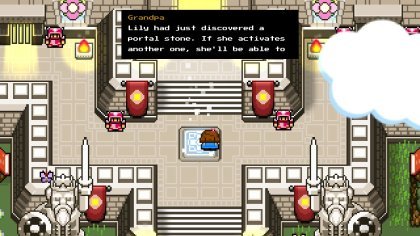
One of the waypoints that you’ll find in Blossom Tales.
Temple Linearity: I spoke a bit earlier about how the world map even feels linear. The temple’s don’t fair much better. Even though you may weave around temple’s room to room, there is typically just one path for you to go down. At times, there may be one large room with four sub rooms, but you are still just moving in a straight line and progressing forward. There’s never a sense of trying to figure out the space you’re occupying. You don’t receive keys to find the locked door. You get a key in a room to unlock the next room, and that’s that.

An example of the linearity you should expect in Blossom Tales.
Ledge Wars: Blossom Tales is really obsessed with knocking you off ledges in every imaginable way, to the point to where it got comical. There are around a dozen rooms that are set up in the same way; player walks through a room or along a pathway, avoid objects and enemies, avoid floor falling behind you and if you’re knocked off you start over. I’m going to leave a gallery of some that I captured during my playthrough once I noticed what was happening.
This slideshow requires JavaScript.
Final Thoughts
Blossom Tales: The Sleeping King was really hit or miss for me. There’s really a barrage of game mechanics that didn’t sit well with me. Things like bombs and arrows felt wonky, there were repeated puzzles, there’s world map and temple linearity, enemy density can be ridiculous and misplaced as well as the ‘ledge rooms.’
However, I did enjoy the integration if the grandfather and children into the story. Having rooms change in front of you based on the narrative of one of the children was fun, and I would like to see more games with that sort of mechanic. I also felt that the sprite work is great and while I wish the world map was handled differently, it does look colorful and varied.
I don’t know if I can say I really enjoyed the experience. It’s around a ten hour game, maybe a bit more if you want to collect 100% of the collectibles. The thing is that it does hit some nostalgia notes of A Link to the Past, but when I think about it, I would rather just go play A Link to the Past instead.
New review for Review: Blossom Tales: The Sleeping King! #nintendo #nintendoswitch #zelda #alttp #actionrpg Introduction Blossom Tales: The Sleeping King had been on my radar for a little while. It had the appearance of a sort of…
0 notes
Text
Review: Master & Apprentice
Check out my thoughts on Claudia Gray's latest #starwars novel here! Review: Master & Apprentice #jedi #obiwankenobi #quigonjinn
I’ve found myself in a bit of a Star Wars phase again when it comes to reading. A few months ago I read Shadows of the Empire for the first time, even though I’ve played through the Nintendo 64 game a dozen times and a few weeks ago, I finished up Alphabet Squadron of the new canon.
I confessed in that review that I really went to the library to get my hands on what I’ll be reviewing today,…
View On WordPress
#alphabet squadron#apprentice#book#book review#claudia gray#jedi#master#master & apprentice#obi-wan kenobi#qui-gon jinn#shadows of the empire#Star Wars
0 notes
Text
Introduction and Story
The Fire Emblem series, for me, has been one of those things that’s always been in my peripheral, but never really close enough to gain attention. I knew of a slew of characters from the Smash Brothers series, that it was a tactics style RPG, had knights, and horses, and magic…and that’s about it. Fire Emblem: Three Houses is the first traditional Fire Emblem game on the Nintendo Switch, and the first game of the series I sought out.
After just finishing my first play through of Fire Emblem: Three Houses, I really didn’t know how to review this game. I typically like to delve into each major mechanic and give insight into how it all ties together, but the idea of touching on everything is daunting for this game.
Fire Emblem: Three Houses is massive. I was initially amazed at how little I actually did after playing for three and a half hours.
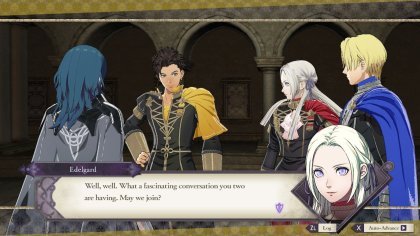
Your three choices, Claude in the yellow, Edelgarde in red and Dmitri in blue.
By nature, there’s three different story line routes for you to take, each with their own twists and turns; The Alliance with Claude, the Empire with Edelgarde, or the Kingdom with Dmitri. There is a mid-point of the game where decisions must be made that drastically impact the rest of the game and splitting off into different forks. For that main reason, you will absolutely need to (and want to) play through multiple times.
With the branching story, each path you take gives you a different experience. My first go around was with Edelgarde and the Empire. I felt that some of the story beats were visible from a mile away, but they were never unsatisfying, and the characters actions in-story always made sense.
There’s a rich history in the world of Fódlan where Three Houses takes place, and I felt the game does a great job in reinforcing that, and making the world feel lived in.
Gameplay
At the start of the game, you’ll be met with a few different difficulty options. First, you have the option of choosing hard or normal difficulty, which is self explanatory. Second, you must choose between classic and casual. Classic means that when one of your character perishes in battle, they are lost forever. Casual means that they more so retreat from battle when defeated, giving you access to them again the next mission.
I originally wanted to go for casual just so that playing the game felt less stressful, because I definitely wouldn’t be able to let one of my students die throughout the game, but I’m happy I didn’t. Going with classic made me rethink how I was going to utilize my team. If there is no risk of permanently losing a member of your team, all you have to do is throw characters at enemies without repercussion and overpower every battle. Part of the fun is treating the battlefield like a chessboard and trying to make smart decisions for that particular round of moves, and a few in the future.
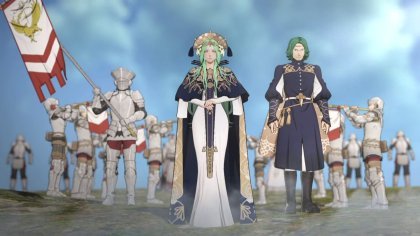
Rhea, Archbishop of the Church of Seiros as well as her second in command, Seteth.
I also went for normal difficulty, but I felt that it was a bit too easy. I never did any grinding and completed all of the story, auxiliary and paralogue battles that popped up. With just that situation, I was consistently over leveling missions I was participating in. It wasn’t until the final two battles that I felt the difficulty spiked.
Aside from difficulty, the gameplay of Fire Emblem: Three Houses is split into a few distinct sections; character development and the actual battles.
The overall template of Fire Emblem: Three Houses ends up feeling like the following; Begin month, instruct your students, build support and relationships between your students and other inhabitants of Garreg Mach, complete quest/auxiliary/paralogue battle, repeat the previous steps 2-3 times per month then complete the month with a story mission between weeks three and four.
You take on the mantle of professor after arriving at Garreg Mach Monastery, choose a class of students to oversee, build relationships with them through different actions that you take, then lead them on the battlefield.
With that in mind, don’t come into the game expecting endless battles and action. Battles become more fun because of the investment you put into your students, your team and goals in terms of selecting future character classes for them to excel at, and eventually become.
Battles
Speaking of battles, the real action in Fire Emblem: Three Houses, comes from the different battle types. If you’ve never played a tactics-RPG game, battle fields are broken down into a grid system similar to a chess or checker board. Each battle has rounds where your team, allied teams and enemy teams are able to move all of their units once. During these rounds is when you would attack, use items, heal team members and so on.

General battle map view, showing you the grid, obstacles, enemies units and more.
Story Battles: These battles, which usually occur once a month in-game, progress the story and usually offer the player the most unique setups. They feature more named characters, which are typically deadlier and require more thought on how to approach them, and more unique side objectives other than ‘rout the enemy’ or ‘defeat the enemy commander.’
Paralogue Battles: These battles hold the best content other than your basic story battles and are always character driven, with a particular conflict or goal in mind. One may require you to block four escape routes for thieves while another has draw bridges in the middle of the map that need to be re-taken. Many of them also reward you with one of the heroes relics and are always worth doing.
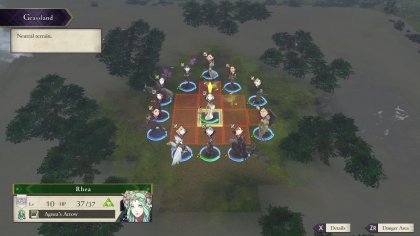
The unique aspect of this paralogue battle puts you in the middle of a battlefield with fog of war surrounding you. You can seek out enemies in the fog, or act defensively and wait for them to come to you.
Auxiliary Battles: These battles also soak up a battle activity point and are a step up in difficulty from basic battles. Many of them include rare beasts and reward you with various meat or resources to continue upgrading or repairing your weapons.
Quest/Basic Battles: Throughout your time at Garreg Mach Monastery, you will get a number of quests that involve a battle, many times rewarding you with another gambit battalion. There’s nothing much else to say about them. They are usually uninteresting and just require you to defeat a number of non-threatening enemies.
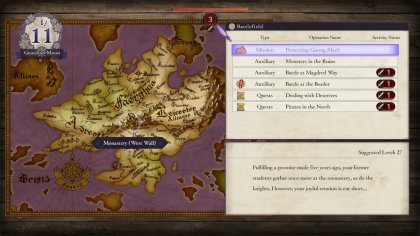
Basic battle list along with activity points on the top of the screen.
The downside of this aspect of the game, is map variety. Too often is a story map revisited for a paralogue battle or vice versa. The auxiliary battles or basic battles also pull from the same pool of maps. There were multiple times that I played through the same map two or three times in a row just completing quests, paralogue’s or even story missions. It would have been nice to have a larger map selection pool so that battling becomes less dull outside of the over-arching narrative.
The Monastery
Garreg Mach Monastery acts as the central hub for most of Fire Emblem: Three Houses and feels like a character on its own. During the story, you’ll slowly unlock areas of the monastery to explore, and subsequently, give you more to do.
This slideshow requires JavaScript.
On top of leveling up your characters in battle, you’re really expected to invest equal time during the following activities to better improve overall.
Professor Level: The professor level allows you to do more actions during the explore phase of the monastery, and gives you more battle points for when you decide to battle instead. You increase this by participating in extracurricular activities that I’ll talk a bit about below, building relationships and completing quests.
Training Grounds: Houses a tournament every month featuring a different weapon type. You choose a character to enter into the tournament. Winning nets you gold, an item and experience towards increasing your professor level.
Dining Hall: Various options available to sit down with other characters and build your relationship with them. A sound strategy would be to eat meals multiple times on the same day to increase the motivation of your students, so when you go to instruct them, they gain greater experience towards the selected skills.
Fishing Pond: Exactly what it sounds like. You use your bait to catch fish to use for meals at the dining hall. Each successful catch nets you a small amount of professor level experience.
Greenhouse/Harvesting: You have the option to plant seeds and cultivate them. Doing this will yield more seeds, items and again, professor level experience.
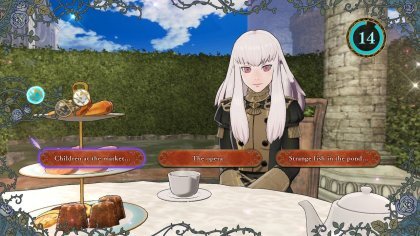
Tea time is another activity you can use to build bonds between yourself and the others at the monastery.
While overall I like the idea of the monastery, it’s design really leaves something on the table. I really don’t care much about having the best graphics, but environments look very blocky and outdated next to the detailed and interesting character models. Everything has a jagged edge, sort of like it was out of the N64/PS1 era, except with better textures.It’s a strange contrast that’s very noticeable.
Characters
One thing I was not expecting, I guess being a newcomer to the series, was how large the character roster is. At first, I was worried about this because how is it possible to get really in depth with everyone and have it not feel superficial? There are always some characters that are developed more than others, and some that are forgotten. This really isn’t the case with Fire Emblem: Three Houses.
I really am blown away with how much personality each character is packed with. The house I chose for my first go around was the Black Eagle House. By the end of the game, following these same characters for nearly 50 hours, I could correctly answer any question they had, have perfect ‘tea times’ every instance, answer their queries correctly in the church and more. I felt that the amplified feeling of knowing they can die in battle also helped me get more attached to them. I never left a character to die, it just didn’t feel like an option.
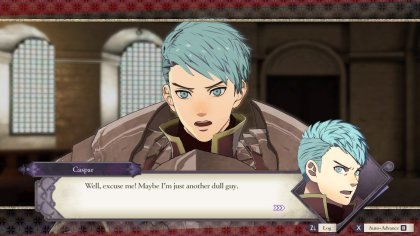
Couldn’t help but think of animated Link saying ‘Excusssse me Princess Zelda.’
Aside from each character having distinct personalities, the voice acting is also superb. I usually read quickly and scroll past text but here, I waited and watched every conversation because of how much I enjoyed the voice acting.
Support Conversations: The more two characters get to know each other, the better their relationship gets. When that happens, support conversations unlock between those two characters, and they are lengthy. I started getting in the habit of waiting until I was eating breakfast to start activating these support conversations because they took so long to go through. At times, I would sit for 30-45 minutes strictly just listening to characters build relationships with one another. It sounds boring on the outside, but it really was a nice change of pace sitting back and enjoying these conversations.
The main growth of a character besides straight leveling up and support levels, are leveling skills and becoming classes that excel at those skills. This is mostly all done during the classroom sessions that you will be setting up for your team. Classes are all visible from the outset, so you can, and should to a degree, plan ahead for certain characters and see what you’d like to be.
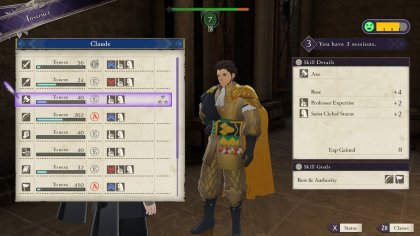
An example of instructing a student on a particular set of skills.
If you really want a Dark Knight on your team, you really need to select an appropriate character, then focus on Reason, Riding and Lance skills. The same goes for any of the other few dozen classes that are obtainable. It’s really an open book, and although certain characters clearly excel at certain skills, you’re never truly bound to those skills. Get creative, and work on what fits your style as a player.
Other Points
Cutscenes: I really enjoyed all of the cutscenes I’ve seen in Fire Emblem: Three Houses. They stand apart from the rest of the game, enacting a more anime style than what is presented elsewhere. Many of them included some unsettling images that reminded me of the feeling I have watching titans contort in Attack on Titan, or even some of the imagery from Berserk.
There are some unintentional comedic elements as well. One cutscene in particular shows three armies rushing towards each other for this grand battle. When it’s over, you head to the battle screen and everyone is standing around waiting for their individual orders.
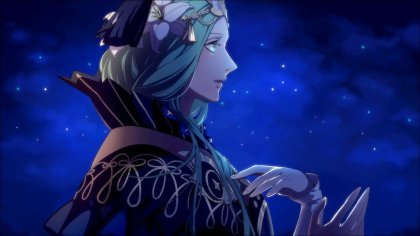
The animation is top notch whenever given to the player. Unfortunately, cutscenes are sparse.
Online Recon: Another addition to Garreg Mach is online recon. When unlocked, an NPC as well as four other characters from other players appear. They each sell you one item at a small discount from just purchasing it in store, and you have the option of doing a mini-game with them. The mini-game scatters them across around half the monastery, and you have to find all four of them within 90 seconds. Rewards for completion include basic food items and one time, a battalion. It’s just strange and super laggy whenever you get near that section of the monastery.

One of the online recon travelers from other players games.
Pacing: The pacing of the main story can feel awkward with the system they have built. They really want to do one main mission every month, with you as the professor, teaching, battling, exploring and everything else during the same month. This is fine for the first half of the game where you are teaching students, and as a class, are being assigned one major mission per month, but the same is not the case for the latter half of the game. I don’t want to go into spoilers, but I felt the system faltered a bit later on and pacing seemed either too rushed, or too slow at times.
Final Thoughts
I’m happy that I took the plunge into the Fire Emblem series. Outside of enjoying the board game/tactics play style, I’m a veteran RPG player, so those long conversations or bonding moments between characters are very welcome and I got just as much enjoyment out of character development as I did actually battling.
The downside, is that map variation was rather boring outside of unique ones used for story or paralogue missions. Graphics are also blocky and seem out of place for this generation of consoles (characters models were a different art style and looked fantastic).
There are three distinct paths for you to choose in Fire Emblem: Three Houses. While the first half of the game may largely be the same for all three choices, the second half is drastically different and you’ll want to check out the other paths.
As long as you aren’t expecting a visual spectacle or non-stop action, you’ll find the same enjoyment that I did with Fire Emblem. Now, onto the second playthrough…
Review: Fire Emblem: Three Houses #fireemblem #threehouses #nintendo #nintendoswitch Introduction and Story The Fire Emblem series, for me, has been one of those things that's always been in my peripheral, but never really close enough to gain attention.
#anime#attack on titan#berserk#fire emblem#fire emblem three houses#nintendo#nintendo switch#rpg#tactics#three houses#turn based
1 note
·
View note